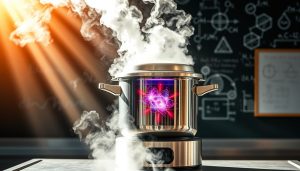Did you know that over 90% of artisanal bakers rely on just four ingredients to create crackly, golden crusts? This magic happens when flour, water, yeast, and salt collide under extreme temperatures. The secret lies in precise chemical reactions – not complex recipes.
During baking, your oven transforms the loaf’s surface into a crispy shield. At 180°F, starches near the exterior burst open, releasing gelatinized compounds. These immediately solidify into a glass-like layer when exposed to dry heat. Professional kitchens use steam injection to delay this hardening, but home bakers achieve similar results through strategic moisture control.
Simple formulas work best for texture development. Enriching agents like butter or eggs trap moisture, creating softer surfaces. That’s why rustic baguettes and sourdough boules – free from additives – develop superior crunch. Mastery comes from balancing hydration levels with thermal management during critical baking phases.
Key Takeaways
- Minimalist recipes maximize crust development by avoiding moisture-retaining ingredients
- Starch gelatinization at 180°F creates the foundation for crisp textures
- Controlled steam exposure during early baking stages enhances crust structure
- Oven temperature accuracy directly impacts surface hardening patterns
- Cooling techniques preserve crunch by preventing residual moisture migration
Exploring the Science Behind the Crust
What transforms dough into that satisfying crackle? It’s a precise dance between physics and chemistry. Three elements drive the transformation: thermal energy, vapor dynamics, and molecular changes in simple ingredients.

Understanding Heat, Steam, and Temperature Effects
Your oven acts as a molecular laboratory. When you slide dough inside, surface moisture evaporates instantly. This triggers starch granules in flour to absorb nearby water molecules. At 180°F, these swollen starches rupture – the critical first step toward crunch.
Professional kitchens use steam injection to manage this reaction. The vapor delays surface drying, allowing loaves to expand fully. Home methods mimic this by placing a preheated cast iron pan on the oven’s lower rack. Adding hot water creates immediate steam when loading dough.
Starch Gelatinization and the Formation of the Crunch
Gelatinized starches form a flexible membrane during early baking. As heat intensifies, this layer dehydrates into a brittle lattice. Precise temperature control ensures complete crystallization without scorching.
Too little steam causes premature hardening. Too much creates a thick, leathery shell. Mastering this balance separates artisanal results from mediocre ones. Your oven’s thermal stability proves vital here – erratic heat disrupts starch transformation.
Techniques to Create and Maintain a Nice Crunch
Mastering texture requires more than just ingredients – it demands smart equipment choices and environmental control. Three approaches dominate professional kitchens and home bakeries alike, each manipulating heat and moisture differently.

Using Steam and Proper Oven Settings
Your oven becomes a steam chamber with simple adjustments. Place a cast iron pan on the bottom rack during preheating. When loading your loaf, toss ice cubes into the scorching pan – they’ll vaporize instantly, creating essential humidity.
Alternative methods work equally well. Spritzing dough with water before baking forms temporary moisture barriers. “The first 10 minutes decide your crust’s fate,” observes James Beard Award-winning baker Mark Furstenberg. “Steam keeps surfaces flexible for optimal expansion.”
Leveraging Baking Tools: Dutch Ovens, Stones, and Pans
Cast iron Dutch ovens act as personal saunas for bread. The sealed environment traps evaporating moisture from the dough itself, creating ideal conditions for crust formation. Remove the lid halfway through baking to finish with crisp results.
Preheated pizza stones and baking steel deliver instant heat to your loaf’s base. These tools absorb thermal energy during preheating, then transfer it rapidly to prevent soggy bottoms. For even browning, position them in the oven’s middle rack.
Water pans offer steady humidity without special equipment. Place them near heating elements to sustain steam production throughout the critical early baking phase.
Why Bread Crust Is Crunchy: Recipe Tips and Processes
Your crust’s destiny is decided during mixing and shaping, not just baking. Successful texture development requires strategic planning from ingredient selection through final proof. Two factors prove critical: minimalist formulas and intentional dough handling.

Choosing the Right Recipe for Artisan-Style Loaves
Four components form the foundation of crisp textures: flour, water, yeast, and salt. Enriching agents like butter or milk create softer surfaces by trapping moisture. “The best recipes let fermentation do the work,” notes San Francisco baking instructor Emily Buehler. “Extended time with a starter develops flavor without compromising structure.”
Hydration levels directly impact thickness. Wetter dough (75-80% water) spreads more during baking, creating thinner results. Lower hydration yields denser crumbs. Your effort in maintaining active cultures pays dividends – vigorous starters improve both rise and texture.
Shaping and Proofing for Maximum Surface Area
Surface exposure determines crunch potential. Baguettes and ciabatta’s elongated forms bake faster, developing more caramelization. Round loaves retain heat longer, leading to thicker exteriors. Use bench knives to create tension without deflating bubbles.
Final proof duration affects both interior and exterior. Under-proofed dough bakes up dense. Over-proofed loaves collapse. Maintain 75°F for optimal activity, watching for 30-50% volume increase before baking.
Troubleshooting Common Crust Issues
Even perfect recipes can yield disappointing results if key variables go unchecked. Successful bakers treat every loaf as a diagnostic opportunity, refining techniques through observation and adjustment.
Preventing Soggy Surfaces After Baking
A soft exterior often signals residual internal moisture. Extend baking time by 5-7 minutes if your sourdough feels heavy. For electric ovens, leave loaves inside with the door cracked open post-bake. This allows gradual evaporation without sudden temperature drops.
Fine-Tuning Fermentation and Structure
Under-proofed dough lacks the gas pockets needed for moisture distribution. Over-fermentation breaks down gluten networks, causing collapse. Track bulk fermentation duration and ambient temperature to hit the sweet spot. Hydration above 75% demands precise shaping to maintain surface tension.
Mastering the Cooling Phase
Transfer baked goods directly to a wire rack immediately after removing from heat. Avoid cutting for at least 2 hours – steam escaping through slices rehydrates the exterior. For extra insurance, position a fan nearby to accelerate airflow without drying the crumb.
Professional bakers swear by thermal probes. Insert one into your loaf’s center – it should read 205-210°F when fully baked. Pair this with audible tests: properly baked sourdough produces a hollow sound when tapped.
Conclusion
Achieving that signature snap in your homemade loaves combines science and craftsmanship. Heat transforms starches, while steam controls hardening. Your oven becomes the ultimate partner when managed precisely – from thermal stability to humidity levels.
Essential tools like steel plates or pizza stones boost heat transfer, creating uniform surfaces. Cast iron pans generate instant vapor during critical early stages. Remember: minimal recipes often yield superior results by letting natural processes shine.
Consistency separates good bakes from great ones. Track fermentation times religiously. Position cooling racks strategically to prevent sogginess. Veteran bakers in online comments stress this truth: every failed loaf teaches more than perfect ones.
Through practice, you’ll master moisture balance and gluten development. Each attempt sharpens your instincts for dough behavior and oven quirks. Start simple, observe outcomes, and let each creation guide your next improvement.



